Total Rewards Model Application: Tinder and Coca-Cola HRM Analysis
VerifiedAdded on 2023/04/20
|16
|4500
|347
Report
AI Summary
This report provides a comparative analysis of the application of the Total Rewards Model within two distinct organizations: Tinder, a micro-business, and Coca-Cola, a multinational corporation. The report employs the WorldatWork Total Rewards Model to examine how each company strategizes to attract, motivate, engage, and retain employees. It explores the specific elements of the model, including benefits, compensation, recognition, work-life effectiveness, talent development, and performance management, within the context of each company's unique operational environment. The report highlights Tinder's use of the Xoxoday Experiences Framework for employee rewards and recognition, as well as Coca-Cola's emphasis on sustainability, human rights, and a diverse work environment. The analysis provides insights into how these companies leverage the Total Rewards Model to achieve organizational success and foster employee satisfaction and productivity. The report also discusses how both companies use long service awards, peer-to-peer rewards, and other reward programs to improve employee engagement.
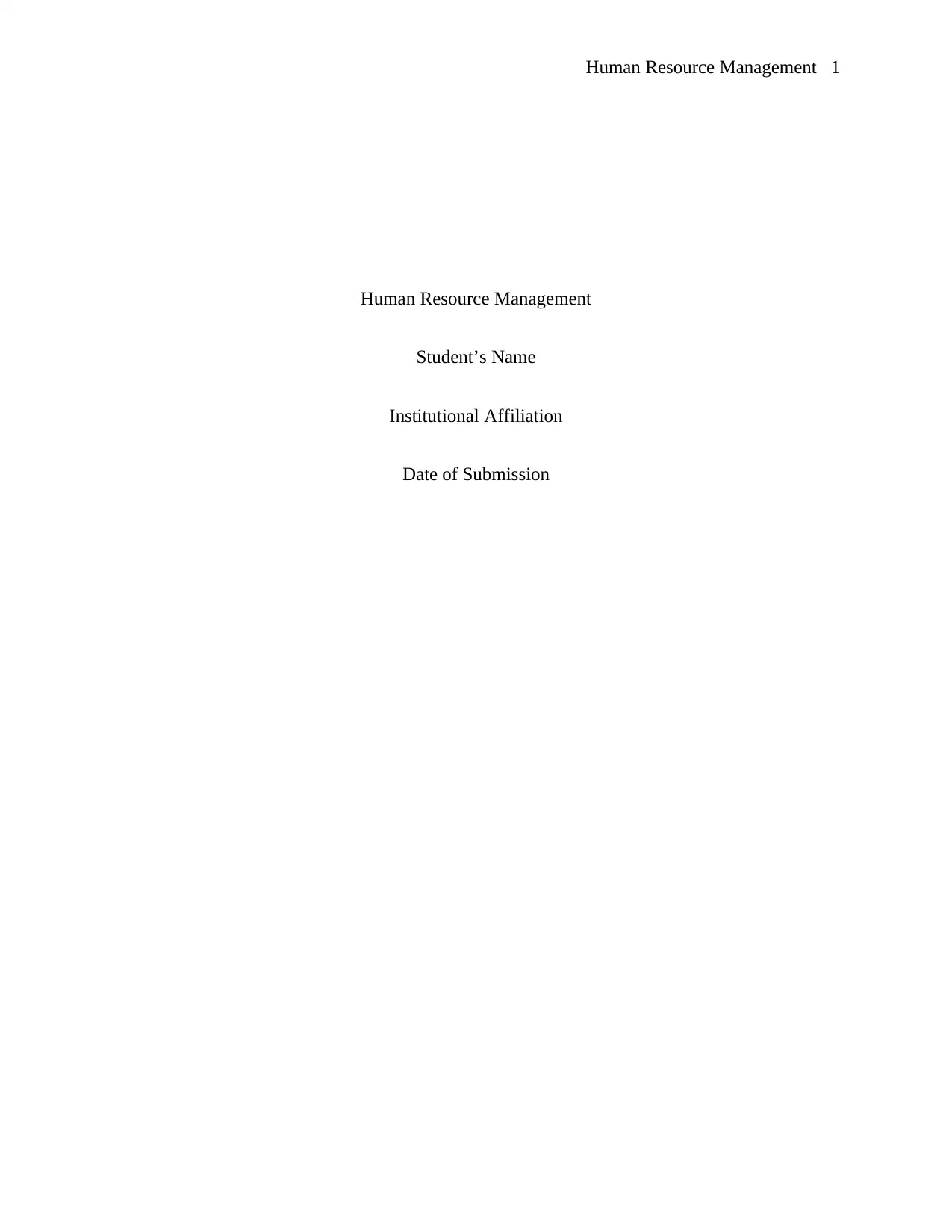
Human Resource Management 1
Human Resource Management
Student’s Name
Institutional Affiliation
Date of Submission
Human Resource Management
Student’s Name
Institutional Affiliation
Date of Submission
Paraphrase This Document
Need a fresh take? Get an instant paraphrase of this document with our AI Paraphraser
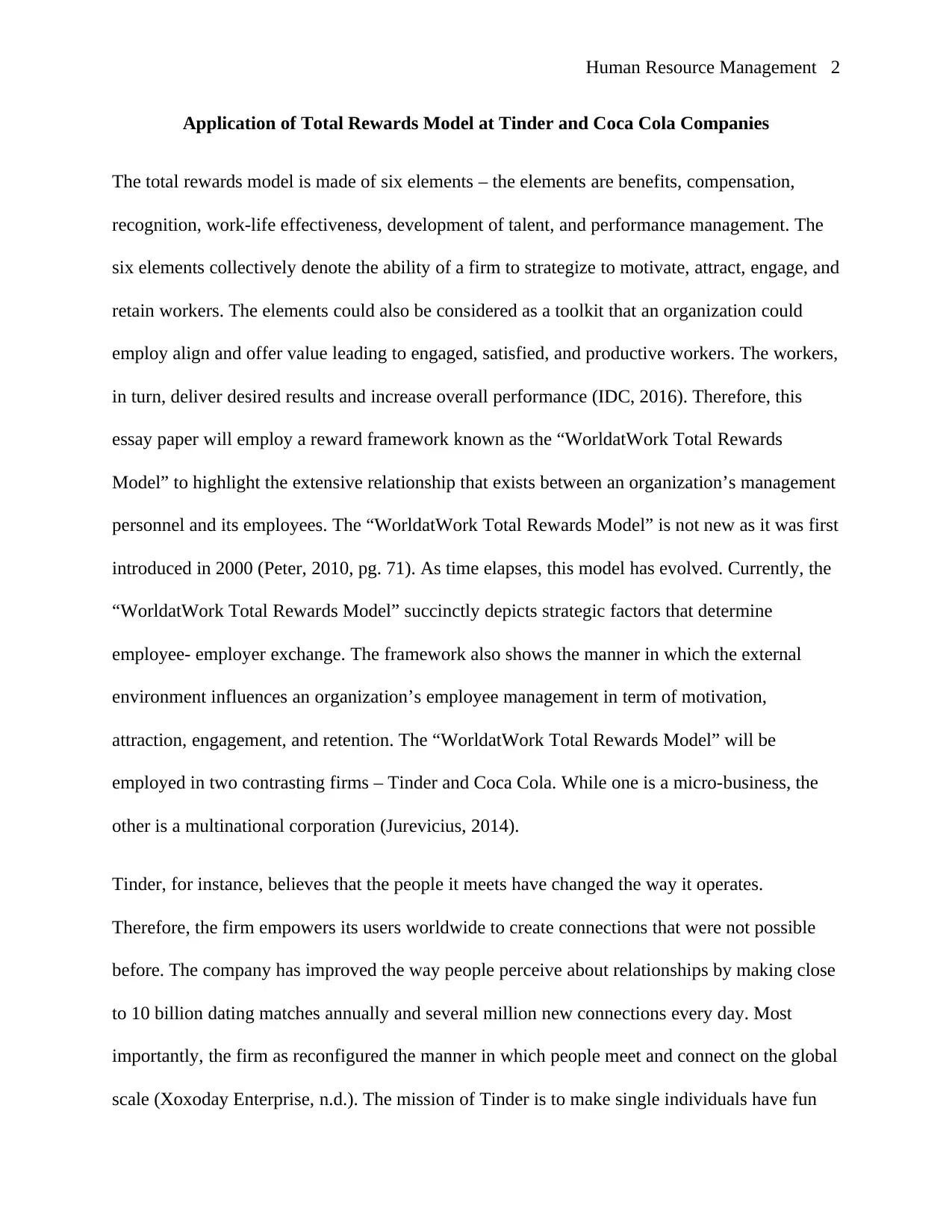
Human Resource Management 2
Application of Total Rewards Model at Tinder and Coca Cola Companies
The total rewards model is made of six elements – the elements are benefits, compensation,
recognition, work-life effectiveness, development of talent, and performance management. The
six elements collectively denote the ability of a firm to strategize to motivate, attract, engage, and
retain workers. The elements could also be considered as a toolkit that an organization could
employ align and offer value leading to engaged, satisfied, and productive workers. The workers,
in turn, deliver desired results and increase overall performance (IDC, 2016). Therefore, this
essay paper will employ a reward framework known as the “WorldatWork Total Rewards
Model” to highlight the extensive relationship that exists between an organization’s management
personnel and its employees. The “WorldatWork Total Rewards Model” is not new as it was first
introduced in 2000 (Peter, 2010, pg. 71). As time elapses, this model has evolved. Currently, the
“WorldatWork Total Rewards Model” succinctly depicts strategic factors that determine
employee- employer exchange. The framework also shows the manner in which the external
environment influences an organization’s employee management in term of motivation,
attraction, engagement, and retention. The “WorldatWork Total Rewards Model” will be
employed in two contrasting firms – Tinder and Coca Cola. While one is a micro-business, the
other is a multinational corporation (Jurevicius, 2014).
Tinder, for instance, believes that the people it meets have changed the way it operates.
Therefore, the firm empowers its users worldwide to create connections that were not possible
before. The company has improved the way people perceive about relationships by making close
to 10 billion dating matches annually and several million new connections every day. Most
importantly, the firm as reconfigured the manner in which people meet and connect on the global
scale (Xoxoday Enterprise, n.d.). The mission of Tinder is to make single individuals have fun
Application of Total Rewards Model at Tinder and Coca Cola Companies
The total rewards model is made of six elements – the elements are benefits, compensation,
recognition, work-life effectiveness, development of talent, and performance management. The
six elements collectively denote the ability of a firm to strategize to motivate, attract, engage, and
retain workers. The elements could also be considered as a toolkit that an organization could
employ align and offer value leading to engaged, satisfied, and productive workers. The workers,
in turn, deliver desired results and increase overall performance (IDC, 2016). Therefore, this
essay paper will employ a reward framework known as the “WorldatWork Total Rewards
Model” to highlight the extensive relationship that exists between an organization’s management
personnel and its employees. The “WorldatWork Total Rewards Model” is not new as it was first
introduced in 2000 (Peter, 2010, pg. 71). As time elapses, this model has evolved. Currently, the
“WorldatWork Total Rewards Model” succinctly depicts strategic factors that determine
employee- employer exchange. The framework also shows the manner in which the external
environment influences an organization’s employee management in term of motivation,
attraction, engagement, and retention. The “WorldatWork Total Rewards Model” will be
employed in two contrasting firms – Tinder and Coca Cola. While one is a micro-business, the
other is a multinational corporation (Jurevicius, 2014).
Tinder, for instance, believes that the people it meets have changed the way it operates.
Therefore, the firm empowers its users worldwide to create connections that were not possible
before. The company has improved the way people perceive about relationships by making close
to 10 billion dating matches annually and several million new connections every day. Most
importantly, the firm as reconfigured the manner in which people meet and connect on the global
scale (Xoxoday Enterprise, n.d.). The mission of Tinder is to make single individuals have fun
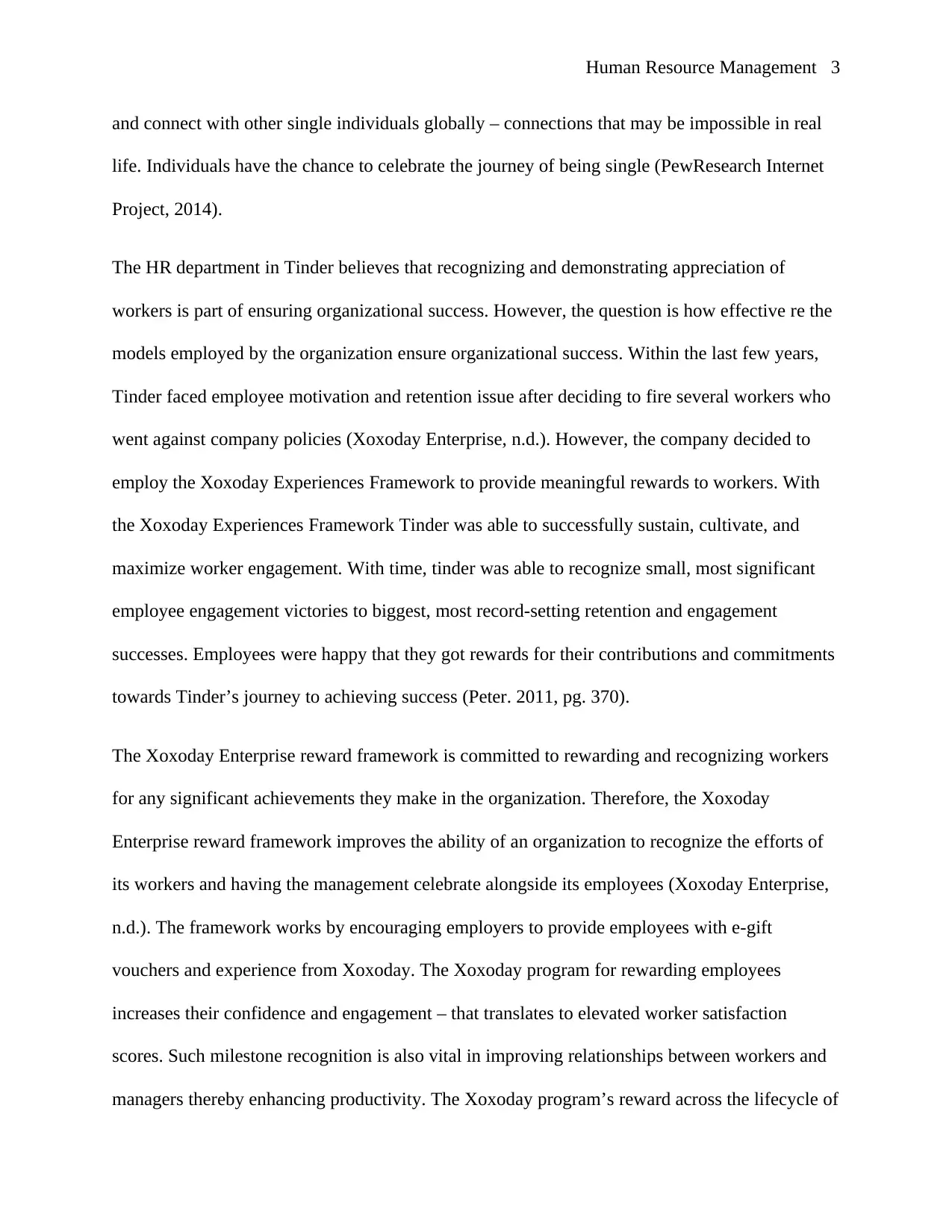
Human Resource Management 3
and connect with other single individuals globally – connections that may be impossible in real
life. Individuals have the chance to celebrate the journey of being single (PewResearch Internet
Project, 2014).
The HR department in Tinder believes that recognizing and demonstrating appreciation of
workers is part of ensuring organizational success. However, the question is how effective re the
models employed by the organization ensure organizational success. Within the last few years,
Tinder faced employee motivation and retention issue after deciding to fire several workers who
went against company policies (Xoxoday Enterprise, n.d.). However, the company decided to
employ the Xoxoday Experiences Framework to provide meaningful rewards to workers. With
the Xoxoday Experiences Framework Tinder was able to successfully sustain, cultivate, and
maximize worker engagement. With time, tinder was able to recognize small, most significant
employee engagement victories to biggest, most record-setting retention and engagement
successes. Employees were happy that they got rewards for their contributions and commitments
towards Tinder’s journey to achieving success (Peter. 2011, pg. 370).
The Xoxoday Enterprise reward framework is committed to rewarding and recognizing workers
for any significant achievements they make in the organization. Therefore, the Xoxoday
Enterprise reward framework improves the ability of an organization to recognize the efforts of
its workers and having the management celebrate alongside its employees (Xoxoday Enterprise,
n.d.). The framework works by encouraging employers to provide employees with e-gift
vouchers and experience from Xoxoday. The Xoxoday program for rewarding employees
increases their confidence and engagement – that translates to elevated worker satisfaction
scores. Such milestone recognition is also vital in improving relationships between workers and
managers thereby enhancing productivity. The Xoxoday program’s reward across the lifecycle of
and connect with other single individuals globally – connections that may be impossible in real
life. Individuals have the chance to celebrate the journey of being single (PewResearch Internet
Project, 2014).
The HR department in Tinder believes that recognizing and demonstrating appreciation of
workers is part of ensuring organizational success. However, the question is how effective re the
models employed by the organization ensure organizational success. Within the last few years,
Tinder faced employee motivation and retention issue after deciding to fire several workers who
went against company policies (Xoxoday Enterprise, n.d.). However, the company decided to
employ the Xoxoday Experiences Framework to provide meaningful rewards to workers. With
the Xoxoday Experiences Framework Tinder was able to successfully sustain, cultivate, and
maximize worker engagement. With time, tinder was able to recognize small, most significant
employee engagement victories to biggest, most record-setting retention and engagement
successes. Employees were happy that they got rewards for their contributions and commitments
towards Tinder’s journey to achieving success (Peter. 2011, pg. 370).
The Xoxoday Enterprise reward framework is committed to rewarding and recognizing workers
for any significant achievements they make in the organization. Therefore, the Xoxoday
Enterprise reward framework improves the ability of an organization to recognize the efforts of
its workers and having the management celebrate alongside its employees (Xoxoday Enterprise,
n.d.). The framework works by encouraging employers to provide employees with e-gift
vouchers and experience from Xoxoday. The Xoxoday program for rewarding employees
increases their confidence and engagement – that translates to elevated worker satisfaction
scores. Such milestone recognition is also vital in improving relationships between workers and
managers thereby enhancing productivity. The Xoxoday program’s reward across the lifecycle of
⊘ This is a preview!⊘
Do you want full access?
Subscribe today to unlock all pages.

Trusted by 1+ million students worldwide
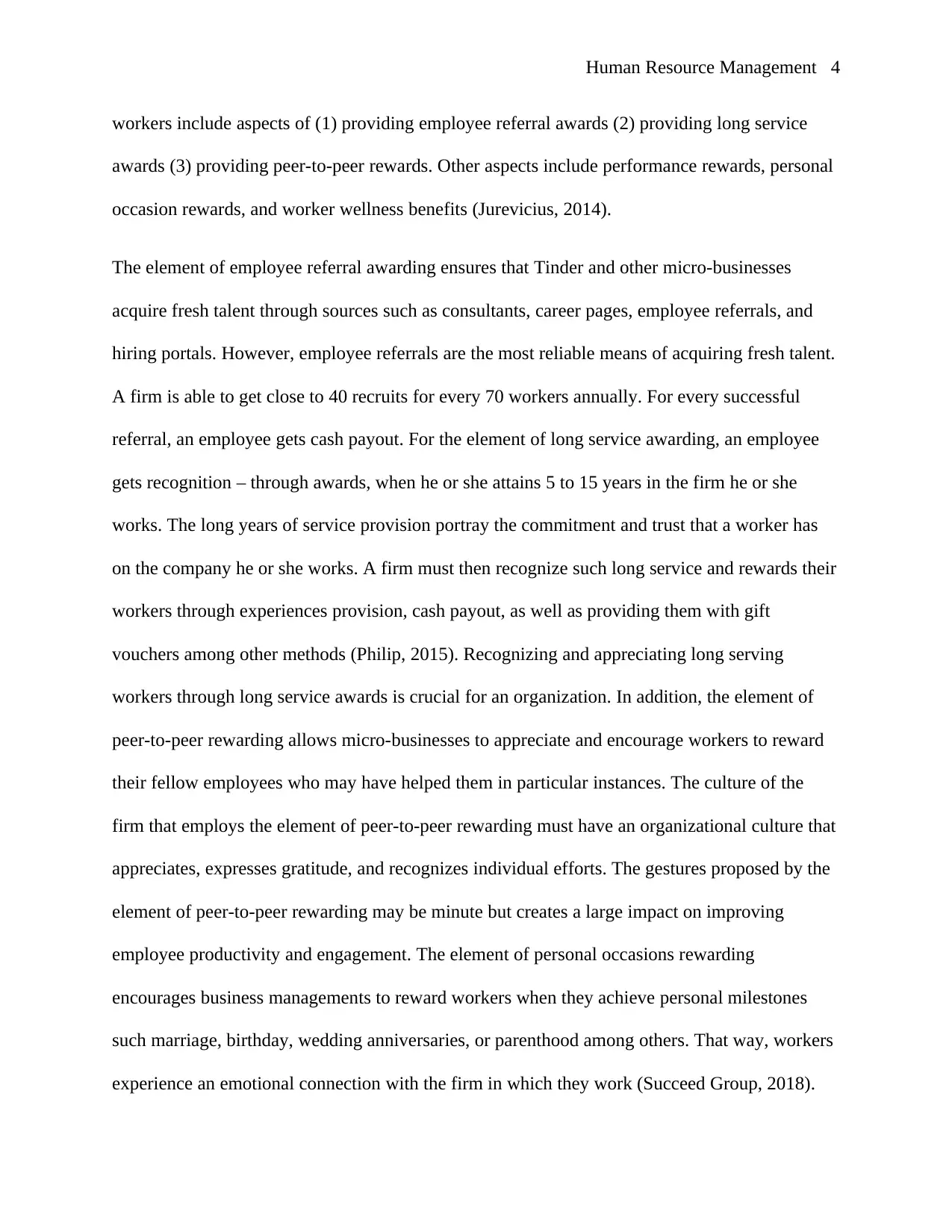
Human Resource Management 4
workers include aspects of (1) providing employee referral awards (2) providing long service
awards (3) providing peer-to-peer rewards. Other aspects include performance rewards, personal
occasion rewards, and worker wellness benefits (Jurevicius, 2014).
The element of employee referral awarding ensures that Tinder and other micro-businesses
acquire fresh talent through sources such as consultants, career pages, employee referrals, and
hiring portals. However, employee referrals are the most reliable means of acquiring fresh talent.
A firm is able to get close to 40 recruits for every 70 workers annually. For every successful
referral, an employee gets cash payout. For the element of long service awarding, an employee
gets recognition – through awards, when he or she attains 5 to 15 years in the firm he or she
works. The long years of service provision portray the commitment and trust that a worker has
on the company he or she works. A firm must then recognize such long service and rewards their
workers through experiences provision, cash payout, as well as providing them with gift
vouchers among other methods (Philip, 2015). Recognizing and appreciating long serving
workers through long service awards is crucial for an organization. In addition, the element of
peer-to-peer rewarding allows micro-businesses to appreciate and encourage workers to reward
their fellow employees who may have helped them in particular instances. The culture of the
firm that employs the element of peer-to-peer rewarding must have an organizational culture that
appreciates, expresses gratitude, and recognizes individual efforts. The gestures proposed by the
element of peer-to-peer rewarding may be minute but creates a large impact on improving
employee productivity and engagement. The element of personal occasions rewarding
encourages business managements to reward workers when they achieve personal milestones
such marriage, birthday, wedding anniversaries, or parenthood among others. That way, workers
experience an emotional connection with the firm in which they work (Succeed Group, 2018).
workers include aspects of (1) providing employee referral awards (2) providing long service
awards (3) providing peer-to-peer rewards. Other aspects include performance rewards, personal
occasion rewards, and worker wellness benefits (Jurevicius, 2014).
The element of employee referral awarding ensures that Tinder and other micro-businesses
acquire fresh talent through sources such as consultants, career pages, employee referrals, and
hiring portals. However, employee referrals are the most reliable means of acquiring fresh talent.
A firm is able to get close to 40 recruits for every 70 workers annually. For every successful
referral, an employee gets cash payout. For the element of long service awarding, an employee
gets recognition – through awards, when he or she attains 5 to 15 years in the firm he or she
works. The long years of service provision portray the commitment and trust that a worker has
on the company he or she works. A firm must then recognize such long service and rewards their
workers through experiences provision, cash payout, as well as providing them with gift
vouchers among other methods (Philip, 2015). Recognizing and appreciating long serving
workers through long service awards is crucial for an organization. In addition, the element of
peer-to-peer rewarding allows micro-businesses to appreciate and encourage workers to reward
their fellow employees who may have helped them in particular instances. The culture of the
firm that employs the element of peer-to-peer rewarding must have an organizational culture that
appreciates, expresses gratitude, and recognizes individual efforts. The gestures proposed by the
element of peer-to-peer rewarding may be minute but creates a large impact on improving
employee productivity and engagement. The element of personal occasions rewarding
encourages business managements to reward workers when they achieve personal milestones
such marriage, birthday, wedding anniversaries, or parenthood among others. That way, workers
experience an emotional connection with the firm in which they work (Succeed Group, 2018).
Paraphrase This Document
Need a fresh take? Get an instant paraphrase of this document with our AI Paraphraser
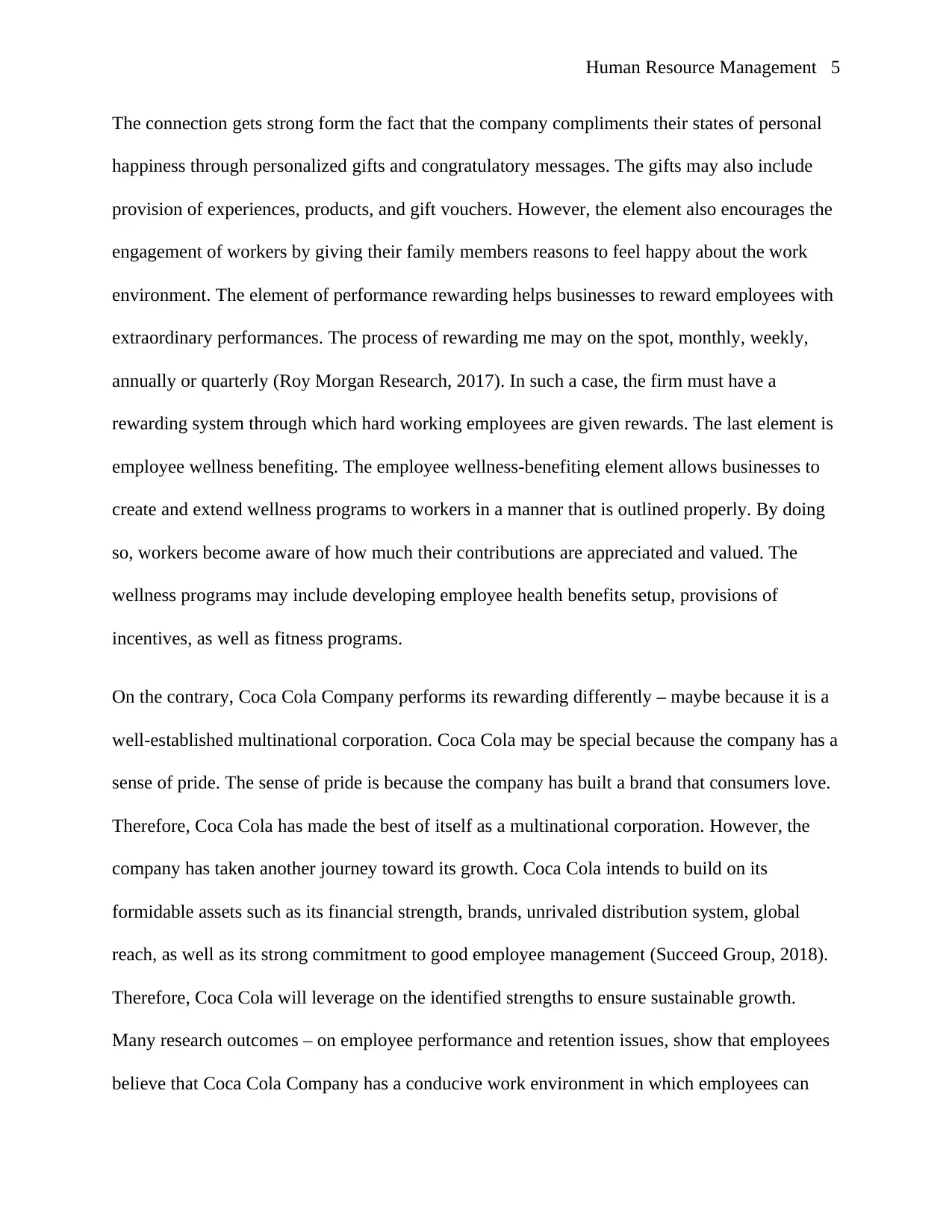
Human Resource Management 5
The connection gets strong form the fact that the company compliments their states of personal
happiness through personalized gifts and congratulatory messages. The gifts may also include
provision of experiences, products, and gift vouchers. However, the element also encourages the
engagement of workers by giving their family members reasons to feel happy about the work
environment. The element of performance rewarding helps businesses to reward employees with
extraordinary performances. The process of rewarding me may on the spot, monthly, weekly,
annually or quarterly (Roy Morgan Research, 2017). In such a case, the firm must have a
rewarding system through which hard working employees are given rewards. The last element is
employee wellness benefiting. The employee wellness-benefiting element allows businesses to
create and extend wellness programs to workers in a manner that is outlined properly. By doing
so, workers become aware of how much their contributions are appreciated and valued. The
wellness programs may include developing employee health benefits setup, provisions of
incentives, as well as fitness programs.
On the contrary, Coca Cola Company performs its rewarding differently – maybe because it is a
well-established multinational corporation. Coca Cola may be special because the company has a
sense of pride. The sense of pride is because the company has built a brand that consumers love.
Therefore, Coca Cola has made the best of itself as a multinational corporation. However, the
company has taken another journey toward its growth. Coca Cola intends to build on its
formidable assets such as its financial strength, brands, unrivaled distribution system, global
reach, as well as its strong commitment to good employee management (Succeed Group, 2018).
Therefore, Coca Cola will leverage on the identified strengths to ensure sustainable growth.
Many research outcomes – on employee performance and retention issues, show that employees
believe that Coca Cola Company has a conducive work environment in which employees can
The connection gets strong form the fact that the company compliments their states of personal
happiness through personalized gifts and congratulatory messages. The gifts may also include
provision of experiences, products, and gift vouchers. However, the element also encourages the
engagement of workers by giving their family members reasons to feel happy about the work
environment. The element of performance rewarding helps businesses to reward employees with
extraordinary performances. The process of rewarding me may on the spot, monthly, weekly,
annually or quarterly (Roy Morgan Research, 2017). In such a case, the firm must have a
rewarding system through which hard working employees are given rewards. The last element is
employee wellness benefiting. The employee wellness-benefiting element allows businesses to
create and extend wellness programs to workers in a manner that is outlined properly. By doing
so, workers become aware of how much their contributions are appreciated and valued. The
wellness programs may include developing employee health benefits setup, provisions of
incentives, as well as fitness programs.
On the contrary, Coca Cola Company performs its rewarding differently – maybe because it is a
well-established multinational corporation. Coca Cola may be special because the company has a
sense of pride. The sense of pride is because the company has built a brand that consumers love.
Therefore, Coca Cola has made the best of itself as a multinational corporation. However, the
company has taken another journey toward its growth. Coca Cola intends to build on its
formidable assets such as its financial strength, brands, unrivaled distribution system, global
reach, as well as its strong commitment to good employee management (Succeed Group, 2018).
Therefore, Coca Cola will leverage on the identified strengths to ensure sustainable growth.
Many research outcomes – on employee performance and retention issues, show that employees
believe that Coca Cola Company has a conducive work environment in which employees can
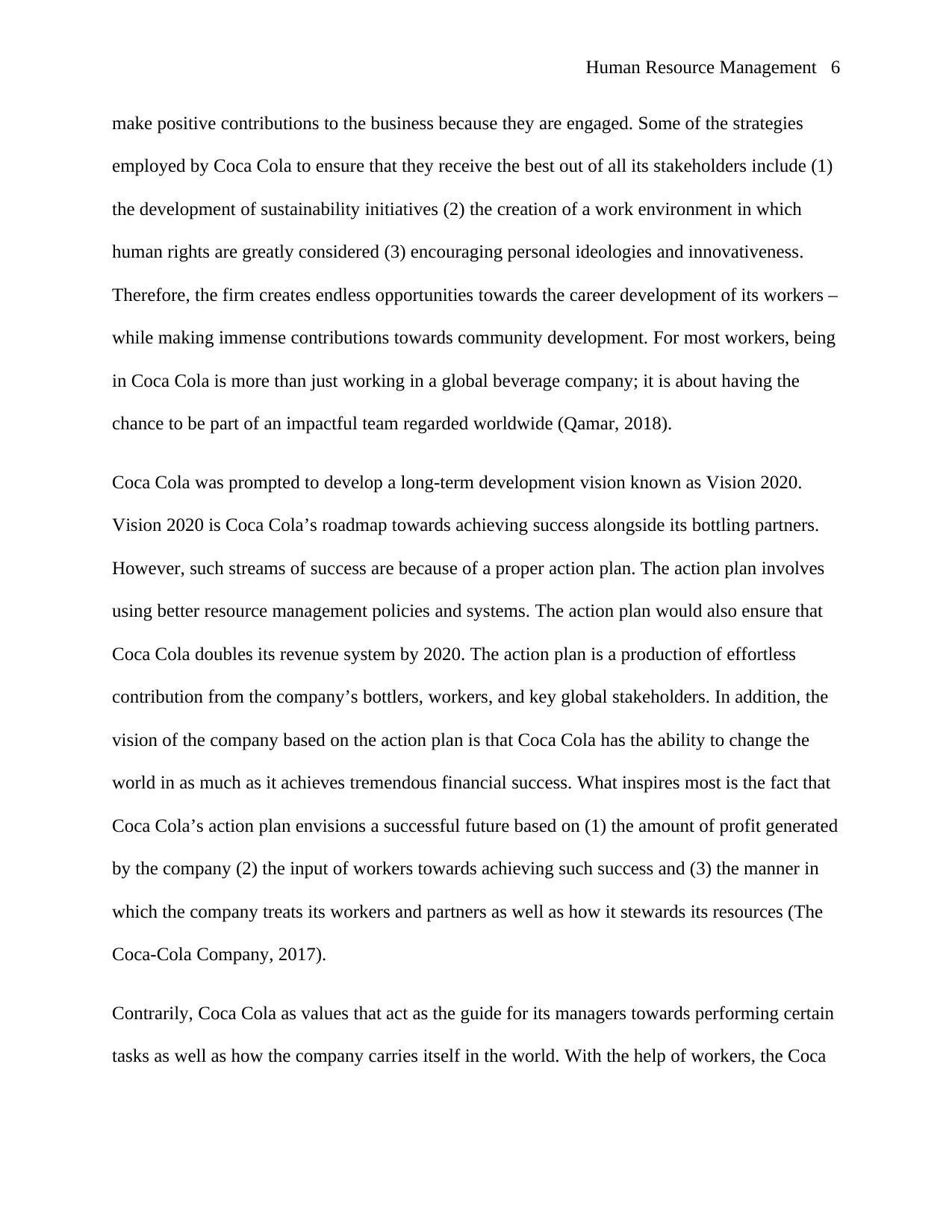
Human Resource Management 6
make positive contributions to the business because they are engaged. Some of the strategies
employed by Coca Cola to ensure that they receive the best out of all its stakeholders include (1)
the development of sustainability initiatives (2) the creation of a work environment in which
human rights are greatly considered (3) encouraging personal ideologies and innovativeness.
Therefore, the firm creates endless opportunities towards the career development of its workers –
while making immense contributions towards community development. For most workers, being
in Coca Cola is more than just working in a global beverage company; it is about having the
chance to be part of an impactful team regarded worldwide (Qamar, 2018).
Coca Cola was prompted to develop a long-term development vision known as Vision 2020.
Vision 2020 is Coca Cola’s roadmap towards achieving success alongside its bottling partners.
However, such streams of success are because of a proper action plan. The action plan involves
using better resource management policies and systems. The action plan would also ensure that
Coca Cola doubles its revenue system by 2020. The action plan is a production of effortless
contribution from the company’s bottlers, workers, and key global stakeholders. In addition, the
vision of the company based on the action plan is that Coca Cola has the ability to change the
world in as much as it achieves tremendous financial success. What inspires most is the fact that
Coca Cola’s action plan envisions a successful future based on (1) the amount of profit generated
by the company (2) the input of workers towards achieving such success and (3) the manner in
which the company treats its workers and partners as well as how it stewards its resources (The
Coca-Cola Company, 2017).
Contrarily, Coca Cola as values that act as the guide for its managers towards performing certain
tasks as well as how the company carries itself in the world. With the help of workers, the Coca
make positive contributions to the business because they are engaged. Some of the strategies
employed by Coca Cola to ensure that they receive the best out of all its stakeholders include (1)
the development of sustainability initiatives (2) the creation of a work environment in which
human rights are greatly considered (3) encouraging personal ideologies and innovativeness.
Therefore, the firm creates endless opportunities towards the career development of its workers –
while making immense contributions towards community development. For most workers, being
in Coca Cola is more than just working in a global beverage company; it is about having the
chance to be part of an impactful team regarded worldwide (Qamar, 2018).
Coca Cola was prompted to develop a long-term development vision known as Vision 2020.
Vision 2020 is Coca Cola’s roadmap towards achieving success alongside its bottling partners.
However, such streams of success are because of a proper action plan. The action plan involves
using better resource management policies and systems. The action plan would also ensure that
Coca Cola doubles its revenue system by 2020. The action plan is a production of effortless
contribution from the company’s bottlers, workers, and key global stakeholders. In addition, the
vision of the company based on the action plan is that Coca Cola has the ability to change the
world in as much as it achieves tremendous financial success. What inspires most is the fact that
Coca Cola’s action plan envisions a successful future based on (1) the amount of profit generated
by the company (2) the input of workers towards achieving such success and (3) the manner in
which the company treats its workers and partners as well as how it stewards its resources (The
Coca-Cola Company, 2017).
Contrarily, Coca Cola as values that act as the guide for its managers towards performing certain
tasks as well as how the company carries itself in the world. With the help of workers, the Coca
⊘ This is a preview!⊘
Do you want full access?
Subscribe today to unlock all pages.

Trusted by 1+ million students worldwide
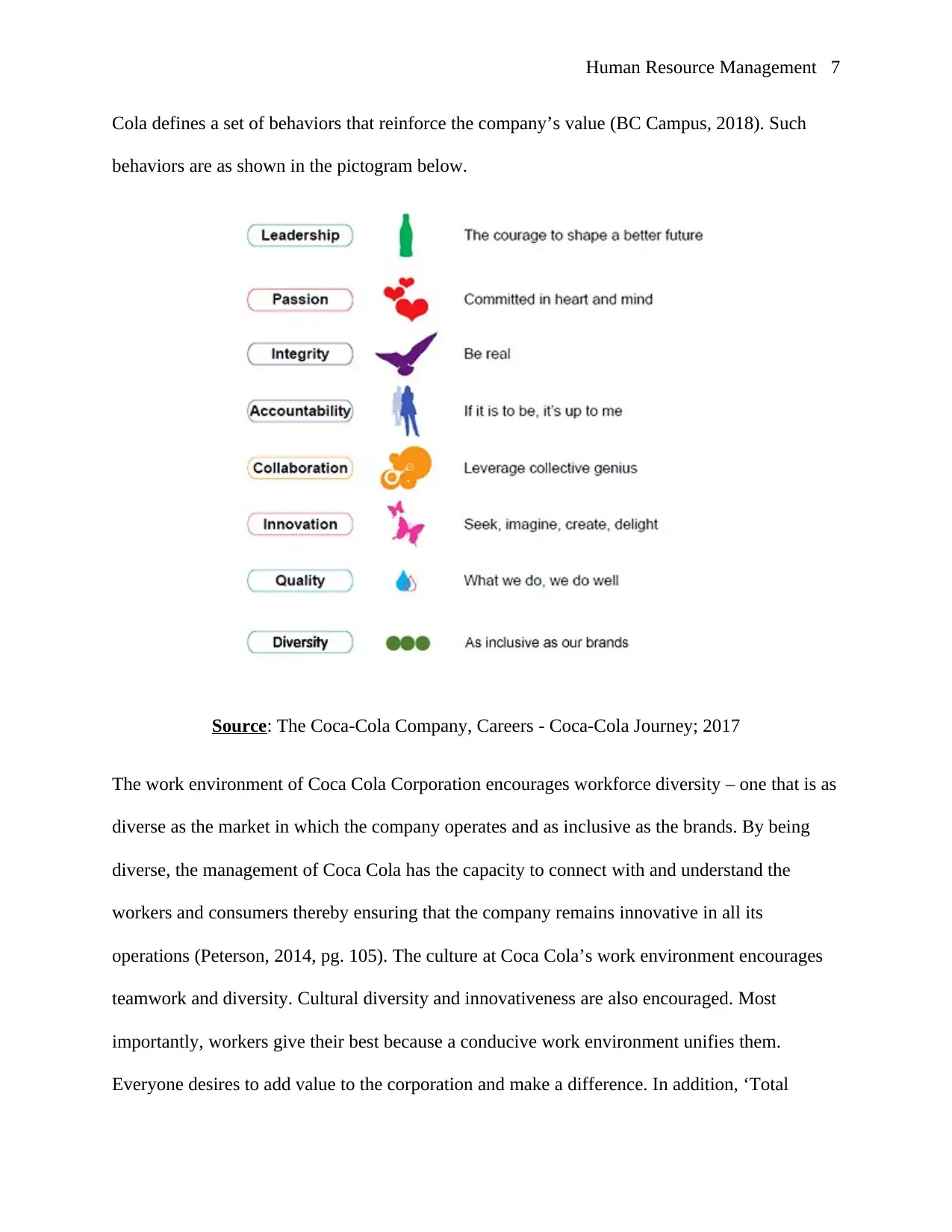
Human Resource Management 7
Cola defines a set of behaviors that reinforce the company’s value (BC Campus, 2018). Such
behaviors are as shown in the pictogram below.
Source: The Coca-Cola Company, Careers - Coca-Cola Journey; 2017
The work environment of Coca Cola Corporation encourages workforce diversity – one that is as
diverse as the market in which the company operates and as inclusive as the brands. By being
diverse, the management of Coca Cola has the capacity to connect with and understand the
workers and consumers thereby ensuring that the company remains innovative in all its
operations (Peterson, 2014, pg. 105). The culture at Coca Cola’s work environment encourages
teamwork and diversity. Cultural diversity and innovativeness are also encouraged. Most
importantly, workers give their best because a conducive work environment unifies them.
Everyone desires to add value to the corporation and make a difference. In addition, ‘Total
Cola defines a set of behaviors that reinforce the company’s value (BC Campus, 2018). Such
behaviors are as shown in the pictogram below.
Source: The Coca-Cola Company, Careers - Coca-Cola Journey; 2017
The work environment of Coca Cola Corporation encourages workforce diversity – one that is as
diverse as the market in which the company operates and as inclusive as the brands. By being
diverse, the management of Coca Cola has the capacity to connect with and understand the
workers and consumers thereby ensuring that the company remains innovative in all its
operations (Peterson, 2014, pg. 105). The culture at Coca Cola’s work environment encourages
teamwork and diversity. Cultural diversity and innovativeness are also encouraged. Most
importantly, workers give their best because a conducive work environment unifies them.
Everyone desires to add value to the corporation and make a difference. In addition, ‘Total
Paraphrase This Document
Need a fresh take? Get an instant paraphrase of this document with our AI Paraphraser
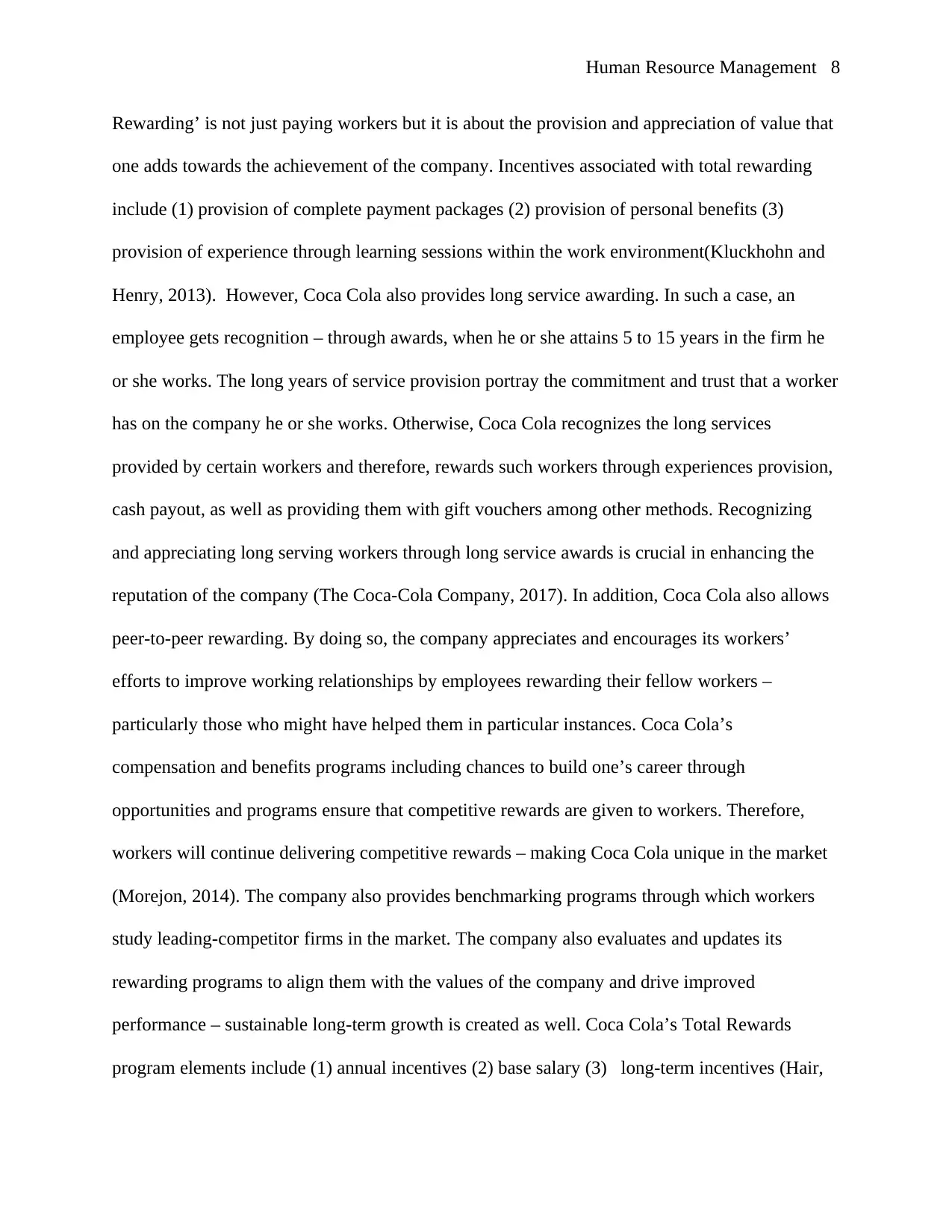
Human Resource Management 8
Rewarding’ is not just paying workers but it is about the provision and appreciation of value that
one adds towards the achievement of the company. Incentives associated with total rewarding
include (1) provision of complete payment packages (2) provision of personal benefits (3)
provision of experience through learning sessions within the work environment(Kluckhohn and
Henry, 2013). However, Coca Cola also provides long service awarding. In such a case, an
employee gets recognition – through awards, when he or she attains 5 to 15 years in the firm he
or she works. The long years of service provision portray the commitment and trust that a worker
has on the company he or she works. Otherwise, Coca Cola recognizes the long services
provided by certain workers and therefore, rewards such workers through experiences provision,
cash payout, as well as providing them with gift vouchers among other methods. Recognizing
and appreciating long serving workers through long service awards is crucial in enhancing the
reputation of the company (The Coca-Cola Company, 2017). In addition, Coca Cola also allows
peer-to-peer rewarding. By doing so, the company appreciates and encourages its workers’
efforts to improve working relationships by employees rewarding their fellow workers –
particularly those who might have helped them in particular instances. Coca Cola’s
compensation and benefits programs including chances to build one’s career through
opportunities and programs ensure that competitive rewards are given to workers. Therefore,
workers will continue delivering competitive rewards – making Coca Cola unique in the market
(Morejon, 2014). The company also provides benchmarking programs through which workers
study leading-competitor firms in the market. The company also evaluates and updates its
rewarding programs to align them with the values of the company and drive improved
performance – sustainable long-term growth is created as well. Coca Cola’s Total Rewards
program elements include (1) annual incentives (2) base salary (3) long-term incentives (Hair,
Rewarding’ is not just paying workers but it is about the provision and appreciation of value that
one adds towards the achievement of the company. Incentives associated with total rewarding
include (1) provision of complete payment packages (2) provision of personal benefits (3)
provision of experience through learning sessions within the work environment(Kluckhohn and
Henry, 2013). However, Coca Cola also provides long service awarding. In such a case, an
employee gets recognition – through awards, when he or she attains 5 to 15 years in the firm he
or she works. The long years of service provision portray the commitment and trust that a worker
has on the company he or she works. Otherwise, Coca Cola recognizes the long services
provided by certain workers and therefore, rewards such workers through experiences provision,
cash payout, as well as providing them with gift vouchers among other methods. Recognizing
and appreciating long serving workers through long service awards is crucial in enhancing the
reputation of the company (The Coca-Cola Company, 2017). In addition, Coca Cola also allows
peer-to-peer rewarding. By doing so, the company appreciates and encourages its workers’
efforts to improve working relationships by employees rewarding their fellow workers –
particularly those who might have helped them in particular instances. Coca Cola’s
compensation and benefits programs including chances to build one’s career through
opportunities and programs ensure that competitive rewards are given to workers. Therefore,
workers will continue delivering competitive rewards – making Coca Cola unique in the market
(Morejon, 2014). The company also provides benchmarking programs through which workers
study leading-competitor firms in the market. The company also evaluates and updates its
rewarding programs to align them with the values of the company and drive improved
performance – sustainable long-term growth is created as well. Coca Cola’s Total Rewards
program elements include (1) annual incentives (2) base salary (3) long-term incentives (Hair,
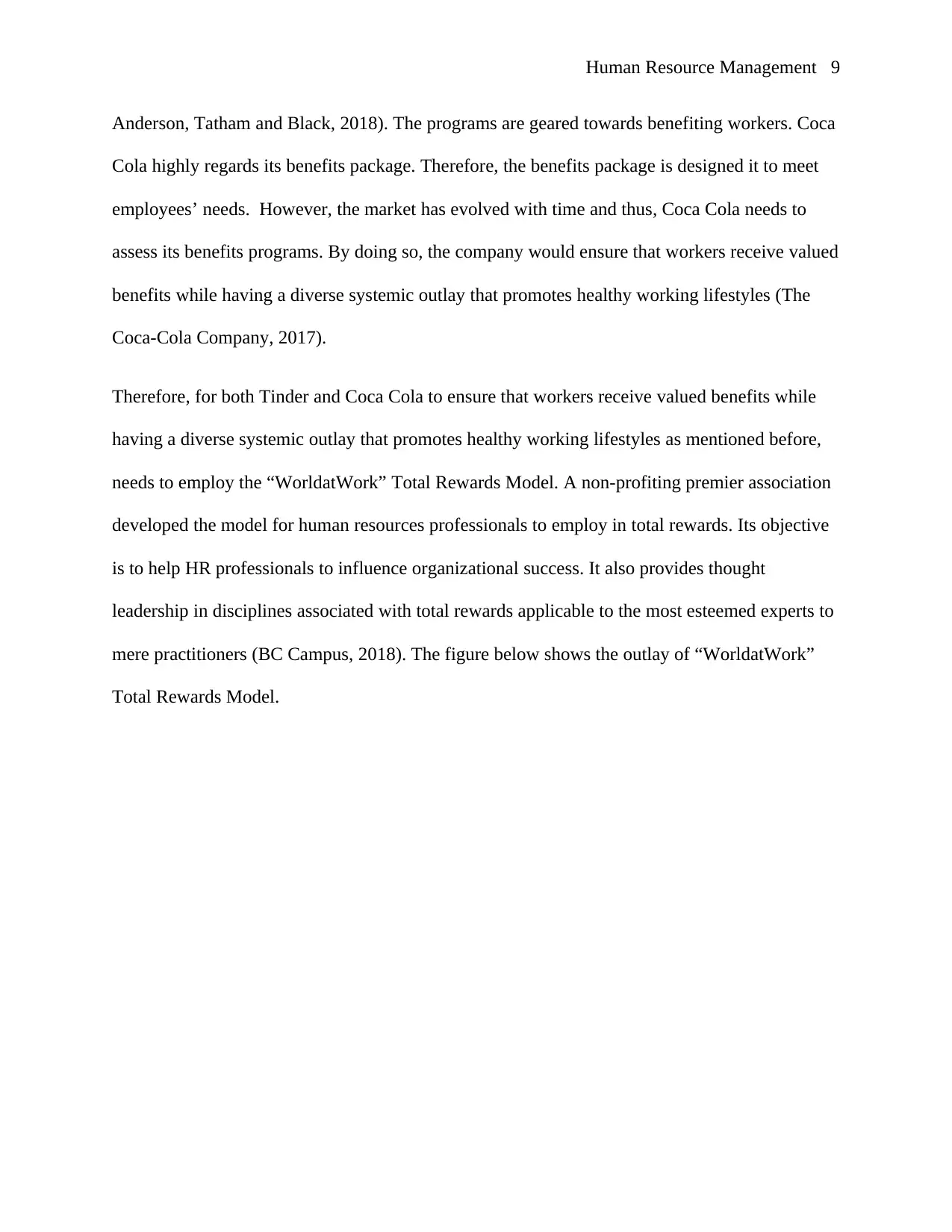
Human Resource Management 9
Anderson, Tatham and Black, 2018). The programs are geared towards benefiting workers. Coca
Cola highly regards its benefits package. Therefore, the benefits package is designed it to meet
employees’ needs. However, the market has evolved with time and thus, Coca Cola needs to
assess its benefits programs. By doing so, the company would ensure that workers receive valued
benefits while having a diverse systemic outlay that promotes healthy working lifestyles (The
Coca-Cola Company, 2017).
Therefore, for both Tinder and Coca Cola to ensure that workers receive valued benefits while
having a diverse systemic outlay that promotes healthy working lifestyles as mentioned before,
needs to employ the “WorldatWork” Total Rewards Model. A non-profiting premier association
developed the model for human resources professionals to employ in total rewards. Its objective
is to help HR professionals to influence organizational success. It also provides thought
leadership in disciplines associated with total rewards applicable to the most esteemed experts to
mere practitioners (BC Campus, 2018). The figure below shows the outlay of “WorldatWork”
Total Rewards Model.
Anderson, Tatham and Black, 2018). The programs are geared towards benefiting workers. Coca
Cola highly regards its benefits package. Therefore, the benefits package is designed it to meet
employees’ needs. However, the market has evolved with time and thus, Coca Cola needs to
assess its benefits programs. By doing so, the company would ensure that workers receive valued
benefits while having a diverse systemic outlay that promotes healthy working lifestyles (The
Coca-Cola Company, 2017).
Therefore, for both Tinder and Coca Cola to ensure that workers receive valued benefits while
having a diverse systemic outlay that promotes healthy working lifestyles as mentioned before,
needs to employ the “WorldatWork” Total Rewards Model. A non-profiting premier association
developed the model for human resources professionals to employ in total rewards. Its objective
is to help HR professionals to influence organizational success. It also provides thought
leadership in disciplines associated with total rewards applicable to the most esteemed experts to
mere practitioners (BC Campus, 2018). The figure below shows the outlay of “WorldatWork”
Total Rewards Model.
⊘ This is a preview!⊘
Do you want full access?
Subscribe today to unlock all pages.

Trusted by 1+ million students worldwide
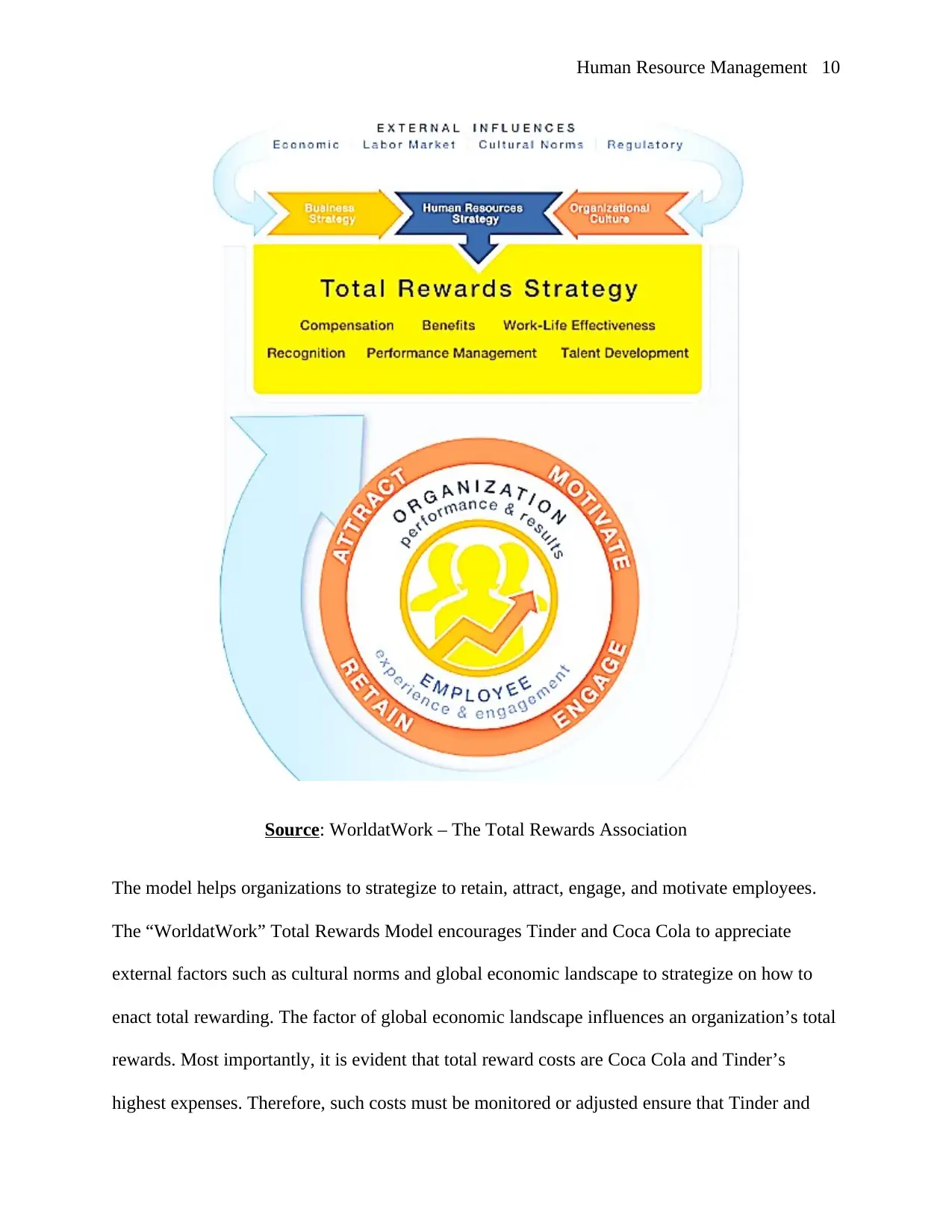
Human Resource Management 10
Source: WorldatWork – The Total Rewards Association
The model helps organizations to strategize to retain, attract, engage, and motivate employees.
The “WorldatWork” Total Rewards Model encourages Tinder and Coca Cola to appreciate
external factors such as cultural norms and global economic landscape to strategize on how to
enact total rewarding. The factor of global economic landscape influences an organization’s total
rewards. Most importantly, it is evident that total reward costs are Coca Cola and Tinder’s
highest expenses. Therefore, such costs must be monitored or adjusted ensure that Tinder and
Source: WorldatWork – The Total Rewards Association
The model helps organizations to strategize to retain, attract, engage, and motivate employees.
The “WorldatWork” Total Rewards Model encourages Tinder and Coca Cola to appreciate
external factors such as cultural norms and global economic landscape to strategize on how to
enact total rewarding. The factor of global economic landscape influences an organization’s total
rewards. Most importantly, it is evident that total reward costs are Coca Cola and Tinder’s
highest expenses. Therefore, such costs must be monitored or adjusted ensure that Tinder and
Paraphrase This Document
Need a fresh take? Get an instant paraphrase of this document with our AI Paraphraser
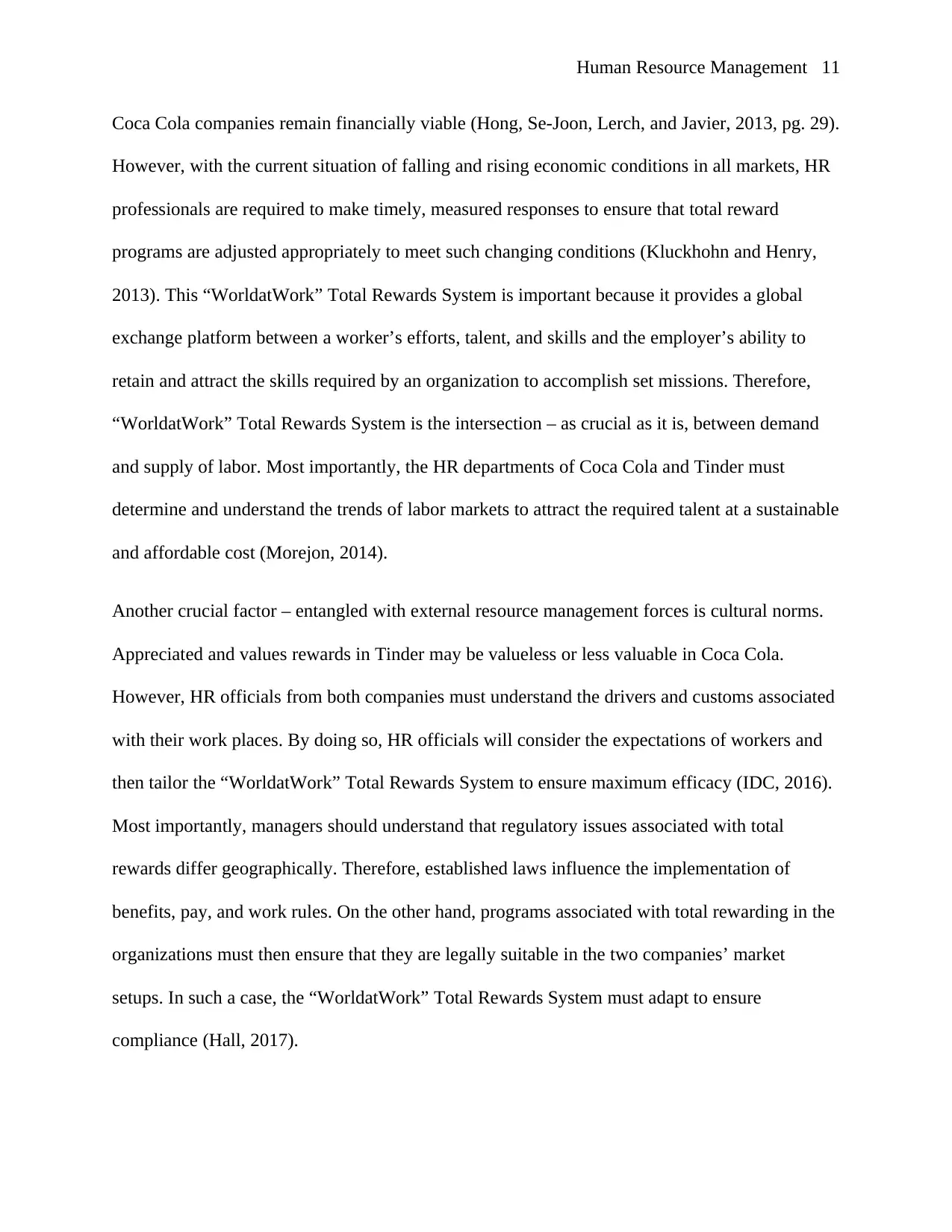
Human Resource Management 11
Coca Cola companies remain financially viable (Hong, Se-Joon, Lerch, and Javier, 2013, pg. 29).
However, with the current situation of falling and rising economic conditions in all markets, HR
professionals are required to make timely, measured responses to ensure that total reward
programs are adjusted appropriately to meet such changing conditions (Kluckhohn and Henry,
2013). This “WorldatWork” Total Rewards System is important because it provides a global
exchange platform between a worker’s efforts, talent, and skills and the employer’s ability to
retain and attract the skills required by an organization to accomplish set missions. Therefore,
“WorldatWork” Total Rewards System is the intersection – as crucial as it is, between demand
and supply of labor. Most importantly, the HR departments of Coca Cola and Tinder must
determine and understand the trends of labor markets to attract the required talent at a sustainable
and affordable cost (Morejon, 2014).
Another crucial factor – entangled with external resource management forces is cultural norms.
Appreciated and values rewards in Tinder may be valueless or less valuable in Coca Cola.
However, HR officials from both companies must understand the drivers and customs associated
with their work places. By doing so, HR officials will consider the expectations of workers and
then tailor the “WorldatWork” Total Rewards System to ensure maximum efficacy (IDC, 2016).
Most importantly, managers should understand that regulatory issues associated with total
rewards differ geographically. Therefore, established laws influence the implementation of
benefits, pay, and work rules. On the other hand, programs associated with total rewarding in the
organizations must then ensure that they are legally suitable in the two companies’ market
setups. In such a case, the “WorldatWork” Total Rewards System must adapt to ensure
compliance (Hall, 2017).
Coca Cola companies remain financially viable (Hong, Se-Joon, Lerch, and Javier, 2013, pg. 29).
However, with the current situation of falling and rising economic conditions in all markets, HR
professionals are required to make timely, measured responses to ensure that total reward
programs are adjusted appropriately to meet such changing conditions (Kluckhohn and Henry,
2013). This “WorldatWork” Total Rewards System is important because it provides a global
exchange platform between a worker’s efforts, talent, and skills and the employer’s ability to
retain and attract the skills required by an organization to accomplish set missions. Therefore,
“WorldatWork” Total Rewards System is the intersection – as crucial as it is, between demand
and supply of labor. Most importantly, the HR departments of Coca Cola and Tinder must
determine and understand the trends of labor markets to attract the required talent at a sustainable
and affordable cost (Morejon, 2014).
Another crucial factor – entangled with external resource management forces is cultural norms.
Appreciated and values rewards in Tinder may be valueless or less valuable in Coca Cola.
However, HR officials from both companies must understand the drivers and customs associated
with their work places. By doing so, HR officials will consider the expectations of workers and
then tailor the “WorldatWork” Total Rewards System to ensure maximum efficacy (IDC, 2016).
Most importantly, managers should understand that regulatory issues associated with total
rewards differ geographically. Therefore, established laws influence the implementation of
benefits, pay, and work rules. On the other hand, programs associated with total rewarding in the
organizations must then ensure that they are legally suitable in the two companies’ market
setups. In such a case, the “WorldatWork” Total Rewards System must adapt to ensure
compliance (Hall, 2017).
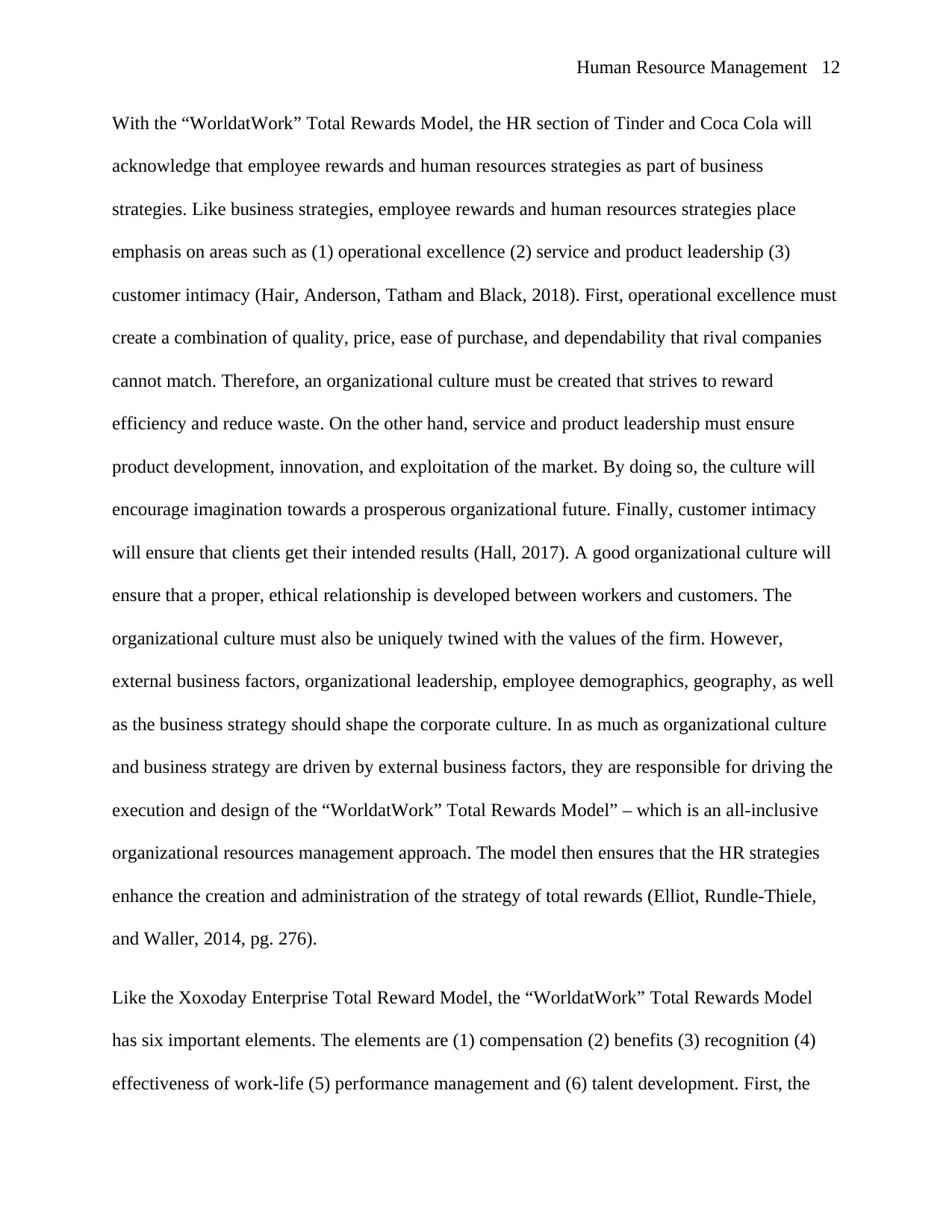
Human Resource Management 12
With the “WorldatWork” Total Rewards Model, the HR section of Tinder and Coca Cola will
acknowledge that employee rewards and human resources strategies as part of business
strategies. Like business strategies, employee rewards and human resources strategies place
emphasis on areas such as (1) operational excellence (2) service and product leadership (3)
customer intimacy (Hair, Anderson, Tatham and Black, 2018). First, operational excellence must
create a combination of quality, price, ease of purchase, and dependability that rival companies
cannot match. Therefore, an organizational culture must be created that strives to reward
efficiency and reduce waste. On the other hand, service and product leadership must ensure
product development, innovation, and exploitation of the market. By doing so, the culture will
encourage imagination towards a prosperous organizational future. Finally, customer intimacy
will ensure that clients get their intended results (Hall, 2017). A good organizational culture will
ensure that a proper, ethical relationship is developed between workers and customers. The
organizational culture must also be uniquely twined with the values of the firm. However,
external business factors, organizational leadership, employee demographics, geography, as well
as the business strategy should shape the corporate culture. In as much as organizational culture
and business strategy are driven by external business factors, they are responsible for driving the
execution and design of the “WorldatWork” Total Rewards Model” – which is an all-inclusive
organizational resources management approach. The model then ensures that the HR strategies
enhance the creation and administration of the strategy of total rewards (Elliot, Rundle-Thiele,
and Waller, 2014, pg. 276).
Like the Xoxoday Enterprise Total Reward Model, the “WorldatWork” Total Rewards Model
has six important elements. The elements are (1) compensation (2) benefits (3) recognition (4)
effectiveness of work-life (5) performance management and (6) talent development. First, the
With the “WorldatWork” Total Rewards Model, the HR section of Tinder and Coca Cola will
acknowledge that employee rewards and human resources strategies as part of business
strategies. Like business strategies, employee rewards and human resources strategies place
emphasis on areas such as (1) operational excellence (2) service and product leadership (3)
customer intimacy (Hair, Anderson, Tatham and Black, 2018). First, operational excellence must
create a combination of quality, price, ease of purchase, and dependability that rival companies
cannot match. Therefore, an organizational culture must be created that strives to reward
efficiency and reduce waste. On the other hand, service and product leadership must ensure
product development, innovation, and exploitation of the market. By doing so, the culture will
encourage imagination towards a prosperous organizational future. Finally, customer intimacy
will ensure that clients get their intended results (Hall, 2017). A good organizational culture will
ensure that a proper, ethical relationship is developed between workers and customers. The
organizational culture must also be uniquely twined with the values of the firm. However,
external business factors, organizational leadership, employee demographics, geography, as well
as the business strategy should shape the corporate culture. In as much as organizational culture
and business strategy are driven by external business factors, they are responsible for driving the
execution and design of the “WorldatWork” Total Rewards Model” – which is an all-inclusive
organizational resources management approach. The model then ensures that the HR strategies
enhance the creation and administration of the strategy of total rewards (Elliot, Rundle-Thiele,
and Waller, 2014, pg. 276).
Like the Xoxoday Enterprise Total Reward Model, the “WorldatWork” Total Rewards Model
has six important elements. The elements are (1) compensation (2) benefits (3) recognition (4)
effectiveness of work-life (5) performance management and (6) talent development. First, the
⊘ This is a preview!⊘
Do you want full access?
Subscribe today to unlock all pages.

Trusted by 1+ million students worldwide
1 out of 16
Related Documents
Your All-in-One AI-Powered Toolkit for Academic Success.
+13062052269
info@desklib.com
Available 24*7 on WhatsApp / Email
![[object Object]](/_next/static/media/star-bottom.7253800d.svg)
Unlock your academic potential
Copyright © 2020–2025 A2Z Services. All Rights Reserved. Developed and managed by ZUCOL.





